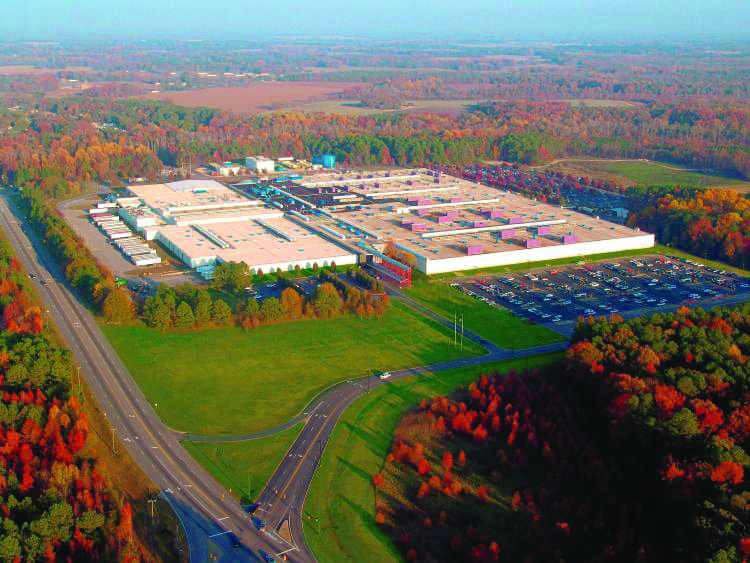Analytics uncovers $95,768 in annual savings
An international automotive components manufacturer is using the Building Clarity Smart Building Analytics Platform to maximize energy efficiency, sustainability achievements, and operational problem prevention at its 1.2 million square-foot North Carolina facility. The facility’s more than 1,800 employees have produced more than four million units since the first one rolled off the line in 1983. This impressive record reflects the hard work, careful maintenance, and advanced technologies that keep the company at the forefront of their industry and on the Fortune 500 list for 65 years.
An example of the company’s successful use of advanced technologies is demonstrated in that, within just three short months, the Building Clarity experts paired with the analytics platform identified practices that are now annually providing the facility with 1,484,727 kWh in electricity savings, $89,084 in electricity utility savings, $6,684 in water utility savings, and 1,050 equivalent metric tons CO2 of greenhouse gas (GHG) emissions prevention.
The facility’s chilled water plant #3 was upgraded with three new centrifugal chillers and BACnet-compatible controls, improvements the facility engineers knew would provide more reliable cooling to the plant. They also knew that better visibility into operating data and trends would enable them to operate the upgraded plant at its optimal efficiency more consistently.
This forward-thinking company diligently stays abreast of emerging technologies that have the potential to improve their operations, their engines, and their efficiency. To this end, the facility has embraced many advanced approaches such as computer-integrated machining, alternative fuels, a new engineering technology center, and others. So they were intrigued when they learned of Building Clarity’s advanced analytics platform. The company saw the potential advantages and savings it could provide and asked Building Clarity if they would be willing to implement the analytics platform in chiller plant #3.
Building Clarity installed their patent-pending IoT gateway and began collecting data from the chiller plant in late summer of 2018. Data is continuously streamed from the network, scrutinized by the SAS-powered advanced analytics, and provided to Building Clarity and the facility engineers for evaluation. Almost immediately, the team began getting actionable data from the platform that started them down a pathway to improved operations and efficiency.
Improved Operational Efficiency
One of the first pieces of information revealed by the data will save the company about 627,894 kWh in annual electricity, $37,674 on their utility bill, and 444 equivalent metric tons in GHG emissions. The analytics exposed that the plant was operating at a 10° F temperature differential between the supplied and returned chilled water. The new chillers were designed, however, to operate at a 20°F difference. Operating at a 10°F differential, also known as low delta–T syndrome, was causing the controls to stage additional chillers before they were actually needed. That meant the plant was operating less efficiently than it could be if it was running at the designed difference of 20°F. Building Clarity provided the team with updated sequences of operation for the pumping system to help overcome those inefficiencies.
Optimized Maintenance
The data also revealed a couple of brief but significant spikes in electricity use in the chiller plant. Building Clarity and the facility engineers met to decipher the cause and were able to pinpoint that the electricity spikes were occurring when the chiller plant equipment was being serviced. Further investigation revealed that the service technicians were turning on all three chillers simultaneously, creating a significant demand peak per event. This important information was used to adjust the servicing protocol to stage one chiller at a time, reducing the demand spike and saving money. At such a large facility, these surges would have gone unnoticed without the deep data provided by the analytics platform.
Innovative Strategies
The facility requires year-round cooling, even during the winter months. The chiller plant is designed to provide 1,850 tons of cooling. The analytics platform revealed that only about 200 tons of cooling is required during the winter months. That information presented an opportunity for facility to use an alternative cooling approach during the winter that would not require the large capacity chiller plant to come on-line during the low-demand season. This approach will save the plant 856,000 kWh per year in electricity, 1,926 ccf per year in water, and about $58,000 in annual utility costs. Building Clarity recommended implementing an airside economizer system. The airside economizer sequence allows for free cooling, requiring less mechanical cooling from the chillers when outdoor conditions are suitable, resulting in substantial energy and cost savings.
Savings and Sustainability
The actionable data generated by the advanced analytics platform provides an excellent rate of return. The facility engineers are looking forward to expanded platform deployment so they can identify and address potential issues before they become full-blown problems that result in production downtime. That type of savings will be even more important.
Not to be overlooked is the company’s corporate mandate to reduce their carbon footprint. The managers at the North Carolina plant diligently looks for ways to increase their facility’s sustainability. They have implemented many commonly used strategies such as switching to LED lighting, installing variable-frequency drives on equipment motors, and more. They were happy to find that the advanced analytics platform identifies other unique and less-obvious opportunities to continue reducing their carbon footprint.
Building Clarity’s advanced analytics platform, powered by SAS, is a cutting-edge tool for improving system operations, efficiency, and savings.
